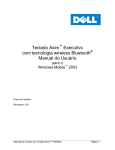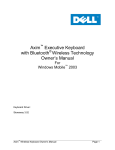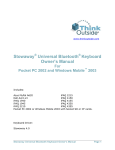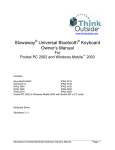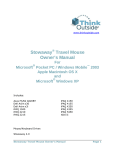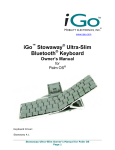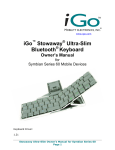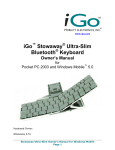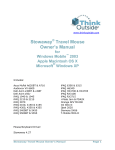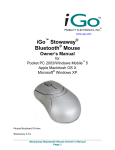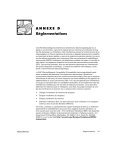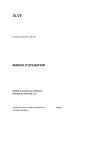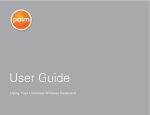Download Think Outside Universal Bluetooth Keyboard Personal Computer User Manual
Transcript
www.thinkoutside.com
Stowaway® Universal Bluetooth® Keyboard
Owner’s Manual
for
Palm OS® Handheld Devices
Includes:
Palm
Palm
Palm
Palm
Palm
Tungsten
Tungsten
Tungsten
Tungsten
Treo 650
E2
T2
T3
T5
Handheld
Handheld
Handheld
Handheld
Keyboard Driver:
Stowaway 3.0T
Page 1
Congratulations!
You have purchased the definitive tool to extend the capabilities of your
handheld computer. The Stowaway Universal Bluetooth Keyboard will
provide you an easy and convenient way to add data to your Palm handheld
device.
The Stowaway Universal Bluetooth Keyboard is the most convenient portable
solution to typing text and commands quickly and easily into your Palm OS
handheld computer. This compact, yet full-sized keyboard lets you:
¾
¾
¾
¾
¾
Type email, meeting minutes, and classroom notes.
Quickly access applications like Date Book, Address and Note Pad.
Type text and special characters.
Access on-screen buttons and menu items.
And much more!
This User Guide will help you get the most out of your Stowaway Universal
Bluetooth Keyboard.
Page 2
Setting up the Keyboard .................................................4
Before you Begin ....................................................................................4
Installing the Software............................................................................4
Configuring the Keyboard to your Palm OS Handheld 5
To Change the General Settings............................................................5
Connected Configuration .......................................................................6
Wireless Configuration (Infrared) ..........................................................7
Bluetooth Configuration.........................................................................8
Assigning Applications to Command Key Combinations.................10
Assigning Applications to Fn Keys.....................................................11
Changing Layout Settings....................................................................12
Working with the Navigator..................................................................13
Viewing Keyboard Shortcuts ...............................................................13
Viewing Keyboard Options ..................................................................14
Keyboard Shortcuts and Special Characters..............15
Moving the Cursor/Highlighting Text ..................................................15
On-Screen Button and Editing Shortcuts ...........................................16
Launching and Navigating Applications.............................................16
Other Shortcuts.....................................................................................17
International and Extended Character Set..........................................17
Frequently Asked Questions ........................................20
Legal Notices..................................................................22
Trademarks............................................................................................22
Warranty ................................................................................................22
Obtaining Warranty Service .................................................................23
Registering Your Product.....................................................................23
Important Battery Information .............................................................24
Important Notes about Bluetooth Devices..........................................24
Regulatory Notices ...............................................................................25
Features and Technical Specifications Summary ......31
Page 3
Setting up the Keyboard
Before you Begin
Before you install the Stowaway Universal Bluetooth Keyboard software for
Palm:
¾ Disable or remove any other keyboard applications that you have
previously installed on your Palm device. (Please refer to the User
Guide included with your Palm for instructions on how to do this.)
¾ Ensure there is at least 200 KB of memory on your Palm device. To
check the available memory: On the Application Launcher screen tap the
clock, then tap Info.
¾ Insert the 2 AAA batteries (included) beneath the battery cover of the
Stowaway Universal Bluetooth Keyboard.
Installing the Software
¾ Connect your Palm OS device to a computer using the HotSync cradle or
cable.
¾ Establish a connection between the computer and your Palm OS device
using HotSync and then backup the data stored on the Palm OS device.
(Please refer to the User Guide included with your Palm OS handheld for
instructions on how to do this.)
¾ Install the software that came with this keyboard, or download the
Stowaway Universal Bluetooth Keyboard software driver for Palm OS to
your computer from Think Outside’s website:
www.thinkoutside.com/support and install to your Palm Desktop.
¾ Perform a HotSync.
¾ Tap the on-screen button to reset your Palm OS device to complete the
installation.
Page 4
Configuring the Keyboard to your Palm OS Handheld
Once you have installed the keyboard software on your handheld, it is
possible to review and customize its performance settings. Use the
Keyboard application on your handheld:
To Change the General Settings
1. Tap the Home icon
.
2. Then tap the Keyboard icon
.
3. Choose General from the pick list in the upper-right corner.
4. Change the settings.
Keyboard
Driver
Select or deselect the check box to turn
the keyboard driver on or off. The default
setting is on.
Key Clicks
Select the check box if you want to hear a
click when you press a key. This is also
affected by the System Sound level option
on your handheld.
Key Repeat
Rate
Drag the indicator to the left to decrease
the repeat rate and to the right to increase
the repeat rate.
Delay Until
Repeat
Drag the indicator to the left to shorten
the delay and to the right to increase the
delay.
Test Repeat
Settings
Test the repeat settings that you selected
in this area.
Page 5
Once you have selected Keyboard
Driver at the General screen, the
Enable Driver dialog will display so
you may select which type of
keyboard to enable.
Connected Configuration
Connected Configuration displays the information about the connection
between the keyboard and your handheld.
NOTE: This screen is for use with keyboards that physically connect to
you handheld. It is not for use with an Infrared Wireless or
Universal Bluetooth Keyboards.
Connected
Keyboard
Select to enable support for the keyboard
that is connected to your handheld.
NOTE: If a connected keyboard is attached to the handheld and this
option is not checked, the handheld will attempt to perform a HotSync
operation. If this happens, cancel the HotSync and check this box.
Page 6
Wireless Configuration (Infrared)
Infrared configuration settings allow you to set when the IR keyboard
turns on and off.
To change IR configuration:
1. From the Keyboard application pick list, select IR Config.
2. Change the settings.
Detect Wireless
Keyboard
Once this is enabled, you have the option
of selecting the level of power the
keyboard will consume.
Max time to detect
Keyboard after
Power-On
You may set the timeframe in seconds for
the keyboard to be detected after a power
on.
IR Auto-Off After
This is used to set the timeframe in
minutes for the Infrared port to
automatically power off.
Test Wireless
Keyboard
You may test the on/off state of the
Wireless Keyboard by typing characters in
this field.
NOTE: When your handheld automatically turns off, you must press
the power button or any application key to turn it back on. Pressing a
keyboard key will not turn on the handheld.
Page 7
Bluetooth Configuration
Bluetooth configuration settings allow you to Connect and Disable the
Stowaway Universal Bluetooth keyboard, check keyboard status, and
test the keyboard settings.
To modify Bluetooth configuration:
1. From the Keyboard application pick list, select Bluetooth Config.
2. Change the settings.
Bluetooth
Keyboard
Check this box to enable the Bluetooth
Keyboard driver.
Secure
This enables a secured connection which
uses a numeric Passkey to pair your Palm
device and your Universal Bluetooth
Keyboard. This allows you to apply
encryption to the Bluetooth signal to
prevent eavesdropping.
NOTE: For a Secured connection, once you have selected Secure and
tapped Connect, the Keyboard Driver dialog will display notifying you
to add the Bluetooth Keyboard to the Trusted Devices List in the
following screen.
Connect
When this is selected, the keyboard
application will begin scanning for a
Bluetooth keyboard.
Page 8
Disconnect
Selecting this will disable the keyboard.
Test Bluetooth
Keyboard
You may test the on/off state of the
Universal Bluetooth Keyboard by typing
characters in this field.
Enter a numeric Passkey of you own choosing from your Palm
Device, select “Add to trusted device list” and follow by tapping OK in
the dialog box. Next, type the same Passkey from the Keyboard using
Blue Fn + number, followed by Enter.
Status showing Stowaway Universal
Bluetooth Keyboard connected with a
Secured connection.
You can now test the connection in
the Test Bluetooth Keyboard field.
NOTE: In the event that multiple Bluetooth keyboards are detected
within range during the Scan, their IDs will be listed. You will be
prompted to select the proper keyboard to connect to before tapping
Connect.
NOTE: When your handheld automatically turns off, you must press
the power button or any application key to turn it back on. Pressing a
keyboard key will not turn on the handheld.
Page 9
Assigning Applications to Command Key Combinations
You can open the main handheld applications –Calendar, Contacts,
Tasks, Memos, Home, Menu, Calculator and Find– using the Blue Fn
key combination with the appropriate application key on the keyboard.
You can also open an application by using a command key combination
that you assign to it.
To assign an application to a command key combination:
1. From the Keyboard application pick list, select CmdKeys.
2. Tap the pick list of the command key combination that you want to
assign to an application.
Tap the arrow to move
through the list one page
at a time
3. Select the application that you want to assign to the key
combination.
You can launch mapped applications in one of two ways:
•
Press Cmd+Blue Fn+the assigned number key.
•
If Numlock (Blue Fn+Caps Lock ) is enabled: Press Cmd+the
assigned number key
Page 10
Assigning Applications to Fn Keys
There are two options for what applications launch when using the
Left Fn key in combination with Home Row keys (for Stowaway users
this applies to the function keys on the far right side of the keyboard in
combination with the Fn key).
Simulate Buttons
This is the default setting and will
launch the applications/functions
that correspond with the printing
on the keys.
Configurable
This allows the user to select the
applications/functions that are
launched. For each key there is a
drop down list of all the
applications/functions currently
installed.
Page 11
Changing Layout Settings
You can select other keyboard layouts and switch between two Tab
options.
To change layout settings:
1. From the keyboard application pick list, select Layout. This refers to
alternate keyboard configurations that may be installed on your
device (e.g. English US (QWERTY), French (AZERTY), German
(QWERTZ), etc.).
2. Change the settings.
Layout
Selects a particular language layout from
the installed layouts.
Tab
Select either “Moves to Next Field”
(default setting) or “Inserts Tab”.
Whichever option you choose, pressing
Fn+Tab performs the other action.
NOTE: You can press either the blue or green Fn button to perform
the alternate tab function.
Layout Info
Displays creation information regarding
the installed layout.
Manage
Layouts
View the databases (.pdb files) for each of
the keyboard layouts.
Page 12
Working with the Navigator
This functionality emulates the 5-way button on the Palm handheld.
Using the Navigator
For handhelds that support the navigator, you can use the following
commands:
Command__________________________ Action______________
Cmd+up arrow
Navigates up
Cmd+down arrow
Navigates down
Cmd+left arrow
Navigates left
Cmd+right arrow
Navigates right
Cmd+Enter
Select
Viewing Keyboard Shortcuts
Your keyboard comes with a full set of keyboard shortcuts for
performing handheld functions.
To view the list of keyboard shortcuts:
1. From the Keyboard application pick list, select the Help option that
corresponds to your keyboard.
4 Row Stowaway XT, Stowaway Infrared Wireless or Stowaway
Universal Bluetooth Keyboard
5 Row
Stowaway Keyboard
2. Select the section you wish to view (e.g. Notes, Fn-App keys, etc.).
3. Use the onscreen scroll bar or the scroll button on the front panel of
your handheld to move through the list.
Page 13
Viewing Keyboard Options
Tap on the Keyboard title in the upper left of the Keyboard
application screen to open the Keyboard Options list showing:
Reset Defaults
About Keyboard
1. To quickly reset all keyboard characteristics back to their
defaults tap Reset Defaults.
2. View the About Keyboard screen to determine the keyboard
software version installed on your handheld device.
Page 14
Keyboard Shortcuts and Special Characters
This section lists the various shortcuts that are available on your
keyboard. The keyboard provides two separate color-coded function
keys (blue Fn and green Fn) that enable you to navigate the
device or access numbers and symbols. Shortcuts are also available
for moving the cursor, selecting text, activating handheld
commands, and creating special characters.
•
Commands joined by a dash “–” mean that the key combination
must be pressed in order and with all keys held down at the
same time.
•
Commands joined by a plus “+” mean that the key following the
“+” must be pressed after the initial key combination is pressed
and released.
Moving the Cursor/Highlighting Text
Use the following commands to move the cursor within documents.
Action
The cursor moves left (back) one word
The cursor moves right (forward) one word
Page up one page at a time
Page down one page at a time
Beginning of the line
End of the line
Shortcut
Ctrl–←
Ctrl-→
RFn–↑
RFn–↓
RFn–←
RFn-→
Select text for subsequent editing functions with these key combinations:
Select
Select
Select
Select
(highlight)
(highlight)
(highlight)
(highlight)
Action
previous line
next line
next character to the left
next character to the right
Page 15
Shortcut
LFn–↑
LFn–↓
LFn–←
LFn–→
On-Screen Button and Editing Shortcuts
From the keyboard, you can activate on-screen buttons such as OK or Done
and access application editing functions. Refer to the following table for the
appropriate keyboard shortcut.
On-Screen Button or Editing Function
OK
Done. Closes a window or application
Cancel
Details
Edit
New
Delete
Note
Send
Turns on Num Lock mode
Turns on Caps Lock mode
Cut selected text
Copy selected text
Paste cut or copied text
Shortcut key
Shortcut
LFn–Z
LFn–X
LFn–C
LFn–V
LFn–B
LFn–N
LFn–M
LFn–,
LFn–.
LFn–Caps Lock
Caps Lock
Ctrl–X
Ctrl–C
Ctrl–V
LFn–Ctrl
Launching and Navigating Applications
To launch software applications and navigate among them, refer to the
following table:
Action
Launch Calendar
Launch Contacts
Launch Tasks
Launch Note Pad
Launch Home
Open Context Menu
Launch Star Application
Launch Find
Launch up to 9 user assigned applications (refer to
CmdKey section for more information)
Launch Keyboard application
Page 16
Shortcut
LFn–A
LFn–S
LFn–D
LFn–F
LFn–J
LFn–K
LFn–L
LFn–;
Cmd+LFn–numbers
1-9
Cmd+LFn–0
Other Shortcuts
Several shortcuts below provide you additional flexibility when using the
Stowaway Universal Bluetooth Keyboard:
Action
Show/hide onscreen International keyboard
Command Stroke
Change screen brightness (where available)
Shortcut
Cmd–Left Spacebar
Cmd
LFn–Delete
International and Extended Character Set
Character
Description
Á, É, Í, Ó, Ú, Ý
á, é, í, ó, ú, ý
Â, Ê, Î, Ô, Û
â, ê, î, ô, û
Ä, Ë, Ï, Ö, Ü, Ÿ
ä, ë, ï, ö, ü, ÿ
À, È, Ì, Ò, Ù
à, è, ì, ò, ù
Ã, Õ, Ñ
ã, õ, ñ
Å
å
Ç
Ø
Acute accent
Acute accent
Circumflex accent
Circumflex accent
Dieresis accent (umlaut)
Dieresis accent (umlaut)
Grave accent
Grave accent
Tilde accent
Tilde accent
Dot accent
Dot accent
Cedilla
Capital naught
Shift–letter + Ctrl–Alt–’
Letter + Ctrl–Alt–’
Shift–letter + Ctrl–Alt–RFn–Y
Letter + Ctrl–Alt–RFn–Y
Shift–letter + Ctrl–Alt–;
Letter + Ctrl–Alt–;
Shift–letter + Ctrl–Alt–LFn–’
Letter + Ctrl–Alt–LFn–’
Shift–letter + Ctrl–Alt–RFn–’
Letter + Ctrl–Alt–RFn–’
Shift–A + Ctrl–Alt–O
A + Ctrl–Alt–O
Ctrl–Alt–C
Ctrl–Alt + Shift–O
ø
Æ
æ
ß
?
¿
!
¡
•
°
µ
Lower case naught
Æ
æ
Beta
Question Mark
Inverted Question Mark
Exclamation
Inverted Exclamation
Bullet
Degrees
Micro
Ctrl–Alt–O
Ctrl–Alt + Shift–A
Ctrl–Alt–A
Alt–L
Shift–↑
Alt–Shift–↑
Page 17
Shortcut
RFn–Q
Alt–RFn–Q
Ctrl–Alt–W
Ctrl–Alt–D
Ctrl–Alt–U
Character
¶
§
Description
Shortcut
Paragraph symbol
Section
Ctrl–Alt–LFn–/
Ctrl–Alt–S
@
©
™
®
£
¥
ƒ
€
At sign
Copyright
Trademark
Registered sign
Pound (Sterling)
Yen
Script F
Euro
RFn–W
Ctrl–Alt–G
Ctrl–Alt–T
Ctrl–Alt–R
RFn–;
RFn–.
Ctrl–Alt–F
RFn–,
¢
$
½
¾
¼
±
÷
Cents
Dollar sign
One-half
Three-quarters
One-quarter
Plus-Minus
Division
Ctrl–Alt–RFn–R
RFn–R
Ctrl–Alt–LFn–W
Ctrl–Alt–LFn–E
Ctrl–Alt–LFn–R
Ctrl–Alt + Shift+=
Ctrl–Alt– –
#
%
^
&
*
(
)
{
}
[
]
|
Number sign
Percent
Caret
Ampersand
Asterisk
Left parenthesis
Right parenthesis
Left curly bracket
Right curly bracket
Left square bracket
Right square bracket
Vertical bar
RFn–E
RFn–T
RFn–Y
RFn–U
RFn–I
RFn–O
RFn–P
RFn– –
RFn– =
LFn– –
LFn– =
RFn– /
Page 18
Alternately, certain special characters may be created in the following way:
Character
á
à
ä
â
å
ã
æ
ç
ñ
Description
Acute a
Grave a
Dieresis (umlaut) a
Circumflex a
Nordic Ring a
Tilde a
Æ
Cedilla c
Tilde n
Alt–Q
Alt–W
Alt–E
Alt–R
Alt–T
Alt–Y
Alt–U
Alt–I
Alt–O
ø
é
è
ë
ê
í
ì
ï
î
ß
ý
ÿ
ó
Slash o
Acute e
Grave e
Dieresis (umlaut) e
Circumflex e
Acute i
Grave i
Dieresis (umlaut) i
Circumflex i
Beta
Acute y
Dieresis (umlaut) y
Acute o
Alt–P
Alt–A
Alt–S
Alt–D
Alt–F
Alt–G
Alt–H
Alt–J
Alt–K
Alt–L
Alt–;
Alt–‘
Alt–Z
ò
ö
ô
õ
ú
ù
ü
û
¿
Grave o
Dieresis (umlaut) o
Circumflex o
Tilde o
Acute u
Grave u
Dieresis (umlaut) u
Circumflex u
Inverted question mark
Alt–X
Alt–C
Alt–V
Alt–B
Alt–N
Alt–M
Alt–,
Alt–.
Alt–/
Page 19
Shortcut
Frequently Asked Questions
Q: What should I do when I type on the keyboard and nothing happens?
•
•
•
•
•
•
Check that your Palm OS device’s batteries are charged.
Check the keyboard’s two AAA batteries.
Check to make sure that your Palm device is powered on and within
range (~10m) of your Bluetooth keyboard.
Check to make sure that the keyboard software is installed properly
according to the instructions.
Check the General screen of the Keyboard application to make sure
you’ve selected Keyboard Driver and the appropriate keyboard type.
After tapping Bluetooth Keyboard you should open the Keyboard
Application pick list and select Bluetooth Config. Then press
Ctrl+LFn+RFn on the keyboard and tap connect on the Bluetooth
Config screen.
Test the on/off state of the keyboard by typing keys from the
keyboard at the Bluetooth Config screen.
Q: Why can’t I synchronize my handheld when using the keyboard?
The Stowaway Universal Bluetooth Keyboard does not replace your handheld
computer’s cradle. To synchronize, connect your handheld to the
synchronization cradle and then synchronize as usual. If your handheld
computer uses a synchronization cable, you may be able to leave the cable
connected.
Q: Can I use my Stowaway Universal Bluetooth Keyboard with other handheld
devices?
Yes. The Stowaway Universal Bluetooth Keyboard, when combined with the
appropriate Stowaway software drivers, is designed to work with handheld
devices equipped with Bluetooth.
Q: How do I install the keyboard driver?
If you have the Stowaway CD, insert it into your CD-ROM drive. The setup
program should start automatically. Optionally, locate the file named
keyboard.prc. Click on the keyboard.prc file and select your user name from
the user list that displays. The next time you HotSync your Palm handheld,
the installation will be completed.
Alternately, it is possible to download the Stowaway Universal Bluetooth
Keyboard software driver for Palm to your computer from Think Outside’s
website: www.thinkoutside.com/support.
Page 20
Q: How do I uninstall the keyboard driver?
Prior to installing a new keyboard driver, it is a good idea to uninstall the
current one. To delete the Keyboard application, go to the Application
screen and tap the clock in the upper left corner. From the dropdown list,
select Delete, then select Keyboard. Tap Delete and Yes to confirm. To
permanently delete the keyboard, open the folder where your Palm software
is installed (X:\Palm or X:\Program Files\Palm, where “X” corresponds with
your hard drive letter). Locate your Palm user name folder and open it.
Locate the Backup folder within it, and look for the keyboard.prc file. Delete
this file from the directory. The next time you perform a HotSync, the
Keyboard application will be removed.
NOTE: You may also delete other programs from your Palm handheld in
this manner.
Q: What are the Connected Config and Wireless Config screens of the Keyboard
application for?
Only users of Stowaway keyboards that use a physical connection or infrared
connections to their Palm device (vs. connection via Bluetooth) will use this
tabs. Users of the Stowaway Universal Bluetooth Keyboard need not pay
attention to this tab.
Page 21
Legal Notices
Think Outside shall not be liable for technical or editorial errors or omissions
contained herein or for special, indirect, incidental or consequential damages
whatsoever in connection with the furnishing, performance, or use of this
material. The information in this document is provided “as is” without
express or implied warranty of any kind, including, but not limited to, the
implied warranties of merchantability and fitness for a particular purpose,
and is subject to change without notice. The warranties for Think Outside
products are set forth in the express limited warranty statements
accompanying such products. Nothing herein should be construed as
constituting an additional warranty. Think Outside assumes no responsibility
for any loss or claims by third parties, which may arise through the use of
this software. Think Outside does not warrant that the software will be
error-free, nor that the software will run uninterrupted. Think Outside
assumes no responsibility for any damage or loss caused by deletion of data
as a result of malfunction, dead battery, or repairs. Be sure to make backup
copies of all important data on other media to protect against data loss.
Information in this document is subject to change without notice.
©2005 Think Outside, Inc. All rights reserved.
Reproduction of this document in any manner whatsoever without the
written permission of Think Outside, Inc. is strictly forbidden.
Trademarks
Think Outside and Stowaway are registered trademarks of Think Outside,
Inc. HotSync® and Palm OS® are registered trademarks of PalmSource,
Inc. Palm is a trademark of palmOne, Inc. Bluetooth® and the Bluetooth
logo are trademarks owned by Bluetooth SIG, Inc., U.S.A. Other trademarks
and trade names may be used in this document to refer to either the entities
claiming the marks and names or their products. No proprietary interest in
other trademarks and trade names is claimed.
Warranty
Think Outside warrants this product against defects in materials and
workmanship under normal use for a period of two (2) years from the date
of original retail purchase. Think Outside’s and its suppliers’ entire liability,
and your exclusive remedy, if you discover a defect and return the product
with proof of purchase to Think Outside during the warranty period, is that
Think Outside will, at its option, repair, replace, or refund the purchase price
of the product to you at no charge. This limited warranty is void if the
defect results from accident, alteration, abuse, improper use, or exposure to
Page 22
water or extreme temperature. TO THE MAXIMUM EXTENT PERMITTED BY
LAW, THIS LIMITED WARRANTY IS EXCLUSIVE AND THINK OUTSIDE
DISCLAIMS ALL OTHER WARRANTIES, EXPRESS OR IMPLIED, INCLUDING
WARRANTIES OF MERCHANTABILITY, FITNESS FOR A PARTICULAR
PURPOSE, TITLE AND NON-INFRINGEMENT. THINK OUTSIDE IS NOT
RESPONSIBLE FOR SPECIAL, INCIDENTAL, INDIRECT OR CONSEQUENTIAL
DAMAGES (INCLUDING WITHOUT LIMITATION, DAMAGES FOR LOST
PROFITS, LOST SAVINGS, OR OTHER DAMAGES) ARISING OUT OF THE USE
OR INABILITY TO USE THE PRODUCT OR THE BREACH OF ANY EXPRESS OR
IMPLIED WARRANTY, EVEN IF THINK OUTSIDE HAS BEEN ADVISED OF THE
POSSIBILITY OF THOSE DAMAGES. Because some jurisdictions do not
permit the exclusion or limitations set forth above, they may not apply in all
cases. This warranty is governed by the laws of the State of California.
Obtaining Warranty Service
Customer must contact Think Outside within the applicable warranty period
to obtain warranty service authorization. Dated proof of original purchase
will be required for warranty service, repair, or replacement. Products or
parts shipped by Customer to Think Outside must be sent postage-paid and
packaged appropriately for safe shipment. Think Outside is not responsible
for Customer products received without a warranty service authorization and
may be rejected. Repaired or replacement products will be shipped to
Customer at Think Outside’s expense. All products or parts that are replaced
become the property of Think Outside. The repair and replacement process
for products or parts in locations outside of the United States will vary
depending on Customer’s location.
[email protected]
Think Outside
85 Saratoga Ave.
Suite 200
Santa Clara, CA 95051
USA
www.thinkoutside.com
Registering Your Product
To register your Stowaway keyboard product, please visit
www.thinkoutside.com/registration and complete the online form.
Page 23
Important Battery Information
•
•
•
•
•
•
Keep batteries away from children.
Do not mix batteries of different types or old and new batteries.
Always replace old, weak or worn-out batteries promptly and recycle
or dispose of them properly. Before inserting new batteries, the
battery compartment should be cleaned. If fluid from the battery
comes into contact with skin or clothes, flush with water immediately.
Remove the batteries if the device will be inactive longer than a
month.
Do not open, puncture or otherwise damage the batteries.
Do not use fire to dispose of batteries.
Released battery electrolyte is corrosive and can cause damage to the eyes
and skin and may be toxic if swallowed.
Comfortable Typing
Research suggests that physical discomfort and injury to nerves, tendons,
and muscles may be related to repetitive motion, an improperly set up work
area, incorrect body posture, and poor work habits.
To reduce the risk of injury, follow these precautions:
•
•
•
•
•
Stand, stretch, and move around several times every hour.
Every once in a while, work on a different task with your hands. Avoid
repetitive motions. Use shortcut keys to move efficiently and avoid
repetitive, awkward movement.
Type gently and lightly.
Relax your shoulders and keep your elbows at your sides. Adjust the
keyboard so that you don’t have to stretch to reach it.
Adjust your position so that you don’t have to bend your wrists to
type; avoid placing your wrists on a sharp edge.
If you feel discomfort of numbness in your hands, wrists, arms, shoulders,
neck or back while typing, get the advice of a qualified medical professional.
Important Notes about Bluetooth Devices
The Stowaway Universal Bluetooth keyboard can emit radio frequency (RF)
energy whenever the green LED is flashing. Care should be taken when used
around medical devices or equipment. For specific information, consult with
the product manufacturer or your physician before use. To stop interference,
close the keyboard or remove its batteries.
The Stowaway Universal Bluetooth keyboard should not be used on
any aircraft. Before boarding an aircraft, close the keyboard to
ensure there is no RF transmission.
Page 24
Regulatory Notices
Electromagnetic Interference (EMI) is any signal or emission, radiated in free
space or conducted along power or signal leads, that endangers the
functioning of radio navigation or other safety service or seriously degrades,
obstructs, or repeatedly interrupts a licensed radio communication service.
Radio communications services include but are not limited to AM/FM
commercial broadcast, television, cellular services, radar, air-traffic control,
pager, and Personal Communication Services (PCS). These licensed services,
along with unintentional radiators such as digital devices, including
computers, contribute to the electromagnetic environment.
Electromagnetic Compatibility is the ability of items of electronic equipment
to function properly together in the electronic environment. While this
keyboard has been designed and determined to be compliant with regulatory
agency limits for EMI, there is no guarantee that interference will not occur
in a particular installation. If this equipment does cause interference with
radio communications services, which can be determined by turning the
equipment off and on, you are encouraged to try to correct the interference
by one or more of the following measures:
•
•
•
Reorient the receiving antenna.
Relocate the keyboard with respect to the receiver.
Move the keyboard away from the receiver.
If necessary, consult an experienced radio/television technician for additional
suggestions.
FCC Notices (U.S. Only)
Most Stowaway keyboards are classified by the Federal Communications
Commission (FCC) as Class B digital devices.
Class B
This equipment has been tested and found to comply with the limits for a
Class B digital device pursuant to Part 15 of the FCC Rules. These limits are
designed to provide reasonable protection against harmful interference in a
residential installation. This equipment generates, uses, and can radiate
radio frequency energy and, if not installed and used in accordance with the
manufacturer’s instruction manual, may case interference with radio
communications. However, there is no guarantee that interference will not
occur in a particular installation. If this equipment does cause harmful
interference to radio or television reception, which can be determined by
Page 25
turning the equipment off and on, you are encouraged to try to correct the
interference by one or more of the following measures:
•
•
•
Reorient or relocate the receiving antenna.
Increase the separation between the equipment and the receiver.
Consult the dealer or an experienced radio/television technician for
help.
FCC Identification Information
The following information is provided on the device or devices covered in this
document in compliance with FCC regulations:
•
Model number(s):
XTBT01
•
Company name:
Think Outside, Inc.
85 Saratoga Ave. Suite 200
Santa Clara, California 95051 USA
(408) 551-4545
IC Notice (Canada Only)
Most Stowaway keyboards are classified by the Industry Canada (IC)
Interference-Causing Equipment Standard #3 (ICES-003) as Class B digital
devices. To determine which classification (Class A or B) applies to your
keyboard, examine all registration labels located on your keyboard. A
statement in the form of "IC Class A ICES-003" or "IC Class B ICES-003" will
be located on one of these labels. Note that Industry Canada regulations
provide that changes or modifications not expressly approved by Think
Outside could void your authority to operate this equipment.
This Class B (or Class A, if so indicated on the registration label) digital
apparatus meets the requirements of the Canadian Interference-Causing
Equipment Regulations.
Cet appareil numérique de la Classe B (ou Classe A, si ainsi indiqué sur
l’étiquette d’enregistration) respecte toutes les exigences du Reglement suer
le Materiel Brouilleur du Canada.
Page 26
CE Notice (European Union)
Marking by
the symbol indicates compliance of this Stowaway keyboard
to the Electromagnetic Compatibility Directive and the Low Voltage Directive
of the European Union. Such marking is indicative that this Stowaway
keyboard meets the following technical standards:
•
•
•
EN 5502 – “Information Technology Equipment – Radio Disturbance
Characteristics – Limits and Methods of Measurement.”
EN 55024 – “Information Technology Equipment - Immunity
Characteristics - Limits and Methods of Measurement.”
EN 60950 – “Safety of Information Technology Equipment.”
NOTE: EN 55022 emissions requirements provide for two classifications:
•
•
Class A is for typical commercial areas.
Class B is for typical domestic areas.
This Think Outside device is classified for use in a typical Class B domestic
environment.
EN 55022 Compliance (Czech Republic Only)
This device belongs to Class B devices as described in EN 55022, unless it is
specifically stated that it is a Class A device on the specification label. The
following applies to devices in Class A of EN 55022 (radius of protection up
to 30 meters). The user of the device is obliged to take all steps necessary
to remove sources of interference to telecommunication or other devices.
Pokud není na typovém štitku počítače uvedeno, že spadá do třídy A
podle EN 55022, spadá automaticky do třídy B podle EN 55022. Pro
zařízení zařazená do třídy A (ochranné pásmo 30m) podle EN 55022
platí následující. Dojde – li k rušení tlekomunikačnich nebo jinych
zařizení, je uživatel povinen provést taková opatření, aby rušení
odstranil.
Page 27
Europe – CE Declaration of Conformity
EN 301 489-1 (December 2001), EN 301 489-17 (December 2001), EN 300
328-1 (August 2002), EN 300 328-2 (August 2002), EN 60950 (January
2000)
English
Hereby, Think Outside, Inc. declares that this
XTBT01 is in compliance with the essential
requirements and other relevant provisions of
Directive 1999/5/EC.
French
Par la présente Think Outside, Inc. Déclare que
l’appareil XTBT01 est conforme aux exigences
essentielles et aux autres dispositions perinentes de
la directive 1999/5/CE.
Par la présente, Think Outside, Inc. Déclare que ce
XTBT01 est conforme aux exigences essentielles et
aux autres dispositions de la directive 1999/5/CE qui
lui sont applicables.
German
Hiermit erkält Think Outside, Inc., dass sich
dieser/diese/dieses XTBT01 in Übereinstimmung mit
den grundlegenden Anforderungen und den anderen
relevanten Vorschriften der Richtlinie 1999/5/EG
befindet. (BMWi)
Hiermit erkält Think Outside, Inc. die
Übereinstimmung des Gerätes tastatur mit den
grundlegenden Anforderungen und den anderen
relevanten Festlegungen der Richtlinie 1999/5/EG.
(Wien)
Italian
Con la presente Think Outside, Inc. Dichiara che
questo XTBT01 è conforme ai requisiti essenziali ed
alle altre disposizioni perteinenti stabilite dalla
direttiva 1999/5/CE.
Page 28
Spanish
Por medio de la presente Think Outside, Inc. Declara
que el XTBT01 cumple con los requisots esenciales y
cualesquirea otras disposiciones aplicables o
exigibles de la Directiva 1999/5/CE.
Portuguese
Think Outside, Inc. Declara que este XTBT01 está
conforme com os requistos essenciais e outra
disposições da Directiva 1999/5/EC.
Finnish
Think Outside, Inc. Vakuuttaa täten että XTBT01
tyyppinen laite on direcktiivin 1999/5/EY oleellisten
vaatimusten ja sitä koskevien directiiven muiden
ehtojen mukainen.
Dutch
Hierbij verklaart Think Outside, Inc. Dat het toestel
XTBT01 in overeenstemming is met de essentiële
eisen en de andere relevante bepalingen van richtlijn
1999/5/EG.
Swedish
Härmed intygar Think Outside, Inc. Att denna
XTBT01 står I överensstämmelse med de väsentliga
egenskapskrav och övriga relevanta bestämmelser
som framgår av direktiv 1999/5/EG.
Danish
Undertengnede Think Outside, Inc. Erklærer herved,
at følgende udstyr XTBT01 overholder de væsentlige
krav og øvrige relevante krav i direktiv 1999/5/EF.
Greek
ΜΕ ΤΗΝ ΠΑΡΟΥΣΑ Think Outside, Inc. ∆ΗΛΩΝΕΙ ΟΤΙ
XTBT01 ΣΥΜΜΟΡΦΩΝΕΤΑΙ ΠΡΟΕ ΤΙΣ ΟΥΣΙΩ∆ΕΙΣ
ΑΠΑΙΤΗΣΕΙΣ ΚΑΙ ΤΙΣ ΛΟΙΠΕΣ ΣΧΕΤΙΚΕΣ ∆ΙΑΤΑΞΕΙΣ
ΤΗΣ Ο∆ΗΓΙΑΣ 1999/5/E
France
Some areas of France have a restricted frequency band. The worst case
maximum authorized power indoors is:
10 mW for the entire 2.4 GHz band (2400 MHz–2483.5 MHz).
100 mW for frequencies between 2446.5 MHz and 2483.5 MHz (NOTE—
Channels 10
through 13 inclusive operate in the band 2446.6 MHz to 2483.5 MHz).
Page 29
There are few possibilities for outdoor use: On private property or on the
private property of public persons, use is subject to a preliminary
authorization procedure by the Ministry of Defence, with maximum
authorized power of 100 mW in the 2446.5–2483.5 MHz band. Use outdoors
on public property is not permitted.
In the departments listed below, for the entire 2.4 GHz band:
Maximum authorized power indoors is 100 mW.
Maximum authorized power outdoors is 10 mW.
Page 30
Features and Technical Specifications Summary
•
Small, foldaway design makes it easy to put in your pocket or briefcase.
•
Simple connection compatibility with your PalmOS® device via Bluetooth.
•
Full size QWERTY keyboard layout for optimum comfort while typing.
Meets ISO/IEC Specification 9995 for full-size keyboards.
•
User-programmable shortcut keys for faster access to applications.
•
On-screen menu and toolbar navigation via keyboard
•
Does not draw power from your Pocket PC device.
•
Rubber grip pads prevent keyboard from slipping while typing.
•
Detachable device stand.
Dimensions Open:
Without stand
With stand
10.28”W x 0.59”H x 3.86”D (261mm x 15mm x 98mm)
10.28”W x 2.05”H x 6.97”D (261mm x 52mm x 177mm)
Dimensions Closed:
5.47”W x 0.79”H x 3.86”D (139mm x 20mm x 98mm)
Weight (including batteries): 6.42 ounces (182 grams)
Operating Temperature Range:
Typical Battery Life:
32° to 120°F (0° to 49°C)
Continuous Operation: ~120 hours
Typical usage:
~3 months
Standby:
~10000 hours
RF Technical specifications
RF output power: Class 2. Maximum output power is 2.5mW (4 dBm).
Protocol: Bluetooth specification v. 1.1 compliant. Bluetooth HID Profile v.
1.0 compliant.
Frequency range: 2.4 – 2.4835GHz
Type of Modulation: GFSK (Gaussian Frequency Shift Keying).
Signal Type: FHSS (Frequency Hopping Spread Spectrum).
© 2005 Think Outside, Inc.
P/N: 101943C
Page 31































